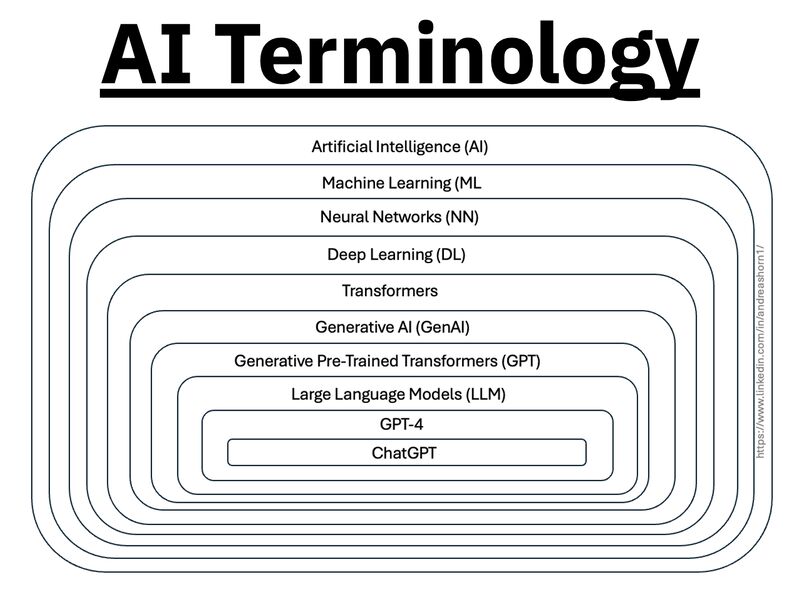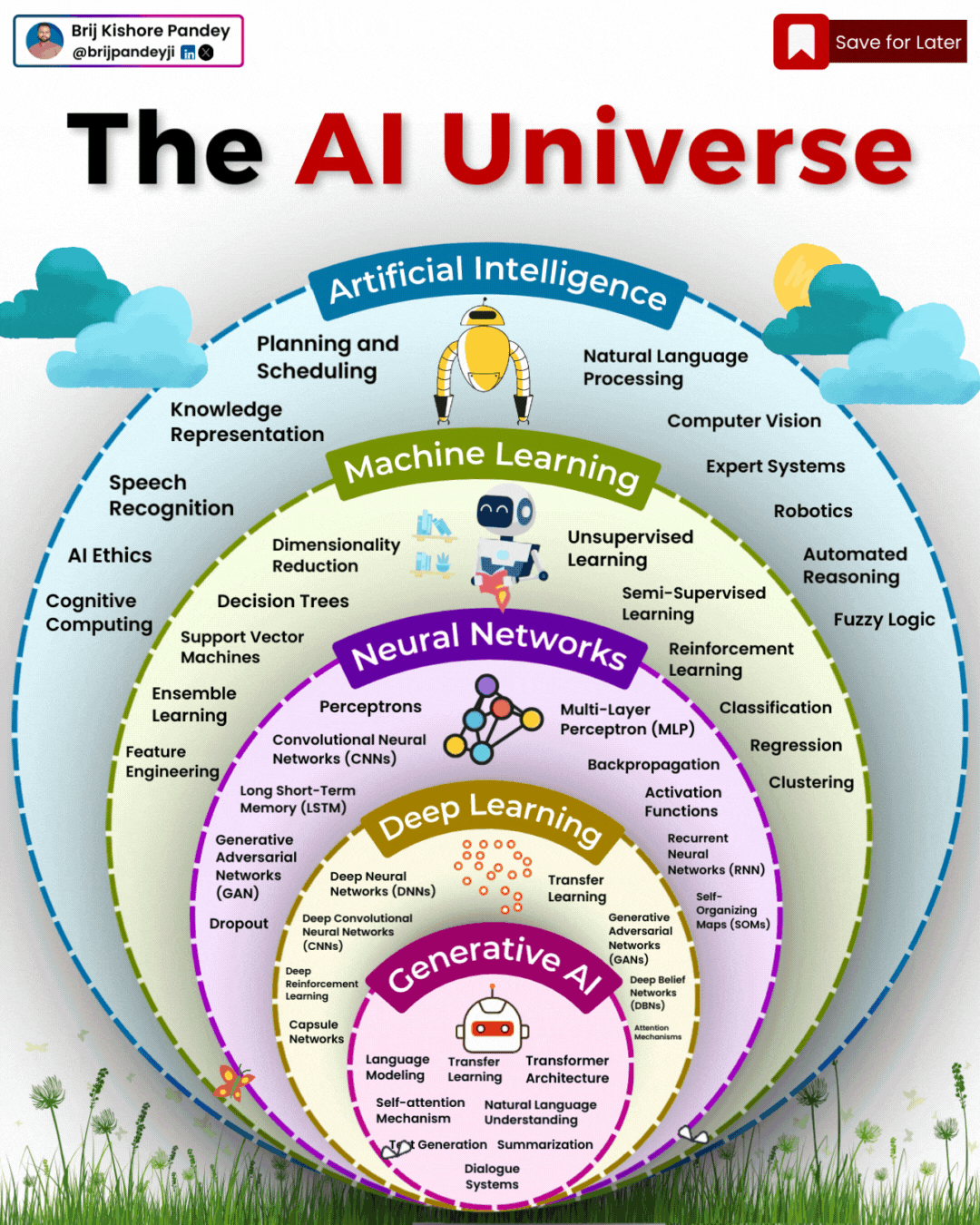-
Types of AI Explained in a few Minutes – AI Glossary
1️⃣ 𝗔𝗿𝘁𝗶𝗳𝗶𝗰𝗶𝗮𝗹 𝗜𝗻𝘁𝗲𝗹𝗹𝗶𝗴𝗲𝗻𝗰𝗲 (𝗔𝗜) – The broadest category, covering automation, reasoning, and decision-making. Early AI was rule-based, but today, it’s mainly data-driven.
2️⃣ 𝗠𝗮𝗰𝗵𝗶𝗻𝗲 𝗟𝗲𝗮𝗿𝗻𝗶𝗻𝗴 (𝗠𝗟) – AI that learns patterns from data without explicit programming. Includes decision trees, clustering, and regression models.
3️⃣ 𝗡𝗲𝘂𝗿𝗮𝗹 𝗡𝗲𝘁𝘄𝗼𝗿𝗸𝘀 (𝗡𝗡) – A subset of ML, inspired by the human brain, designed for pattern recognition and feature extraction.
4️⃣ 𝗗𝗲𝗲𝗽 𝗟𝗲𝗮𝗿𝗻𝗶𝗻𝗴 (𝗗𝗟) – Multi-layered neural networks that drives a lot of modern AI advancements, for example enabling image recognition, speech processing, and more.
5️⃣ 𝗧𝗿𝗮𝗻𝘀𝗳𝗼𝗿𝗺𝗲𝗿𝘀 – A revolutionary deep learning architecture introduced by Google in 2017 that allows models to understand and generate language efficiently.
6️⃣ 𝗚𝗲𝗻𝗲𝗿𝗮𝘁𝗶𝘃𝗲 𝗔𝗜 (𝗚𝗲𝗻𝗔𝗜) – AI that doesn’t just analyze data—it creates. From text and images to music and code, this layer powers today’s most advanced AI models.
7️⃣ 𝗚𝗲𝗻𝗲𝗿𝗮𝘁𝗶𝘃𝗲 𝗣𝗿𝗲-𝗧𝗿𝗮𝗶𝗻𝗲𝗱 𝗧𝗿𝗮𝗻𝘀𝗳𝗼𝗿𝗺𝗲𝗿𝘀 (𝗚𝗣𝗧) – A specific subset of Generative AI that uses transformers for text generation.
8️⃣ 𝗟𝗮𝗿𝗴𝗲 𝗟𝗮𝗻𝗴𝘂𝗮𝗴𝗲 𝗠𝗼𝗱𝗲𝗹𝘀 (𝗟𝗟𝗠) – Massive AI models trained on extensive datasets to understand and generate human-like language.
9️⃣ 𝗚𝗣𝗧-4 – One of the most advanced LLMs, built on transformer architecture, trained on vast datasets to generate human-like responses.
🔟 𝗖𝗵𝗮𝘁𝗚𝗣𝗧 – A specific application of GPT-4, optimized for conversational AI and interactive use.

-
Change to Adobe terms & conditions outrages many professionals
https://9to5mac.com/2024/06/06/change-to-adobe-terms-amp-conditions
The terms say:
Solely for the purposes of operating or improving the Services and Software, you grant us a non-exclusive, worldwide, royalty-free sublicensable, license, to use, reproduce, publicly display, distribute, modify, create derivative works based on, publicly perform, and translate the Content. For example, we may sublicense our right to the Content to our service providers or to other users to allow the Services and Software to operate with others, such as enabling you to share photos
Designer Wetterschneider, who counts DC Comics and Nike among his clients, was one of the graphics pros to object to the terms.
Here it is. If you are a professional, if you are under NDA with your clients, if you are a creative, a lawyer, a doctor or anyone who works with proprietary files – it is time to cancel Adobe, delete all the apps and programs. Adobe can not be trusted.
Movie director Duncan Jones was equally blunt in his response.
Hey @Photoshop what the hell was that new agreement you forced us to sign this morning that locked our ap until we agree to it? We are working on a bloody movie here, and NO, you don’t suddenly have the right to any of the work we are doing on it because we pay you to use photoshop. What the f**k?!
Should you ditch Photoshop with immediate effect?
https://www.creativeboom.com/resources/should-you-ditch-photoshop-with-immediate-effect/
Adobe’s response
Adobe is not claiming ownership over the content you create in Photoshop. Likewise, it will not use customer content to train its Firefly generative AI model.
-
Ashton Kutcher Says Soon ‘You’ll Be Able to Render a Whole Movie’ Using AI
https://variety.com/2024/film/news/ashton-kutcher-ai-movies-sora-hollywood-1236027196/
“I have a beta version of it and it’s pretty amazing,” Kutcher said of the platform in a recent conversation with former Google CEO Eric Schmidt at the Berggruen Salon in Los Angeles.
“Why would you go out and shoot an establishing shot of a house in a television show when you could just create the establishing shot for $100? To go out and shoot it would cost you thousands of dollars,” Kutcher said. “Action scenes of me jumping off of this building, you don’t have to have a stunt person go do it, you could just go do it [with AI].
-
Managing Motivation, as a Solo Developer
https://mbuffett.com/posts/maintaining-motivation
- External Triggers: Utilize notifications for new subscribers or feedback.
- Task Management: Leave tasks 90% complete to facilitate easy restarts.
- Product Use: Regularly use your own product to identify improvements.
- Pain Point Solutions: Continuously improve processes to address pain points.
- Breaks: Take regular breaks to prevent burnout.
- User Updates: Keep users informed about progress.
- Accountability Partners: Collaborate with someone to maintain accountability.
- Daily Productivity: Ensure no “zero days” of productivity.
- Flexible Work Hours: Work whenever motivation strikes, even at unconventional hours.
-
Adobe scolded for selling ‘Ansel Adams-style’ images generated by AI
https://www.theverge.com/2024/6/3/24170285/adobe-stock-ansel-adams-style-ai-generated-images
Adobe responded to the callout, saying it had removed the offending content and had privately messaged the Adams estate to get in touch directly in the future. The Adams estate, however, said it had contacted Adobe directly multiple times since August 2023.
“Assuming you want to be taken seriously re: your purported commitment to ethical, responsible AI, while demonstrating respect for the creative community, we invite you to become proactive about complaints like ours, & to stop putting the onus on individual artists/artists’ estates to continuously police our IP on your platform, on your terms,” said the Adams estate on Threads. “It’s past time to stop wasting resources that don’t belong to you.”
-
Python – The Black code style formatting
https://black.readthedocs.io/en/stable/the_black_code_style/current_style.html
The Black code style guide emphasizes consistency, readability, and minimizing diffs in Python code. Key formatting rules include ignoring previous formatting, preferring double quotes, adding trailing commas, and wrapping lines to fit within 88 characters. Black standardizes whitespace usage, avoids unnecessary vertical space, and ensures uniform handling of parentheses, comments, and numeric literals. The formatter also aligns with PEP 8 and PEP 257 standards, and provides options to adjust line length and skip string normalization for specific projects.
-
Want to build a start up company that lasts? Think three-layer cake
https://www.fastcompany.com/91131427/want-to-build-a-company-that-lasts-think-three-layer-cake
Building a successful business requires a focus on three key elements: product excellence, go-to-market strategy, and operational excellence. Neglecting any of these areas can lead to failure, as evidenced by the high percentage of startups that don’t make it past the five-year mark. Founders and CEOs must ensure a solid product foundation while also integrating effective sales, marketing, and management strategies to achieve sustainable growth and scale.
- Foundation: Product Excellence, Core Values and Mission
- Core Values: These are the guiding principles that dictate behavior and action within the company. They form the ethical foundation and are crucial for maintaining consistency in decision-making.
- Mission: This defines the company’s purpose and goals. A clear and compelling mission helps align the team and provides a sense of direction.
- Efficiency and Scalability: This layer focuses on creating efficient processes that can scale as the company grows. Streamlined operations reduce costs and increase productivity.
- Structure: Operational Excellence and Innovation
- Operational Excellence: Efficient processes, quality control, and continuous improvement fall into this layer. Ensuring that the company operates smoothly and effectively is crucial for sustainability.
- Innovation: Staying competitive requires innovation. This involves developing new products, services, or processes that add value and keep the company relevant in the market.
- Quality Control and Continuous Improvement: Ensuring that operational processes are of high quality and constantly improving helps maintain product excellence and customer satisfaction.
- Technology and Infrastructure: Investing in the right technology and infrastructure to support business operations is vital. This includes everything from manufacturing equipment to software systems that enhance operational efficiency.
- Strategy: Go-to-Market Strategy, Vision and Long-Term Planning
- Vision: A forward-looking vision inspires and motivates the team. It outlines where the company aims to be in the future and helps in setting long-term goals.
- Strategic Planning: This involves setting long-term goals and determining the actions and resources needed to achieve them. It includes market analysis, competitive strategy, and growth planning.
- Market Understanding: A deep understanding of the target market, including customer segments, competitors, and market trends, is essential. This knowledge helps in positioning the product effectively.
- Marketing and Sales Execution: This involves creating a robust marketing plan that includes branding, messaging, and advertising strategies to attract and retain customers. Additionally, building a strong sales strategy ensures that the product reaches the right customers through the right channels.
- Customer Acquisition and Retention: Effective strategies for acquiring new customers and retaining existing ones are critical. This includes loyalty programs, customer service excellence, and engagement initiatives.
- Foundation: Product Excellence, Core Values and Mission
COLLECTIONS
| Featured AI
| Design And Composition
| Explore posts
POPULAR SEARCHES
unreal | pipeline | virtual production | free | learn | photoshop | 360 | macro | google | nvidia | resolution | open source | hdri | real-time | photography basics | nuke
FEATURED POSTS
Social Links
DISCLAIMER – Links and images on this website may be protected by the respective owners’ copyright. All data submitted by users through this site shall be treated as freely available to share.




